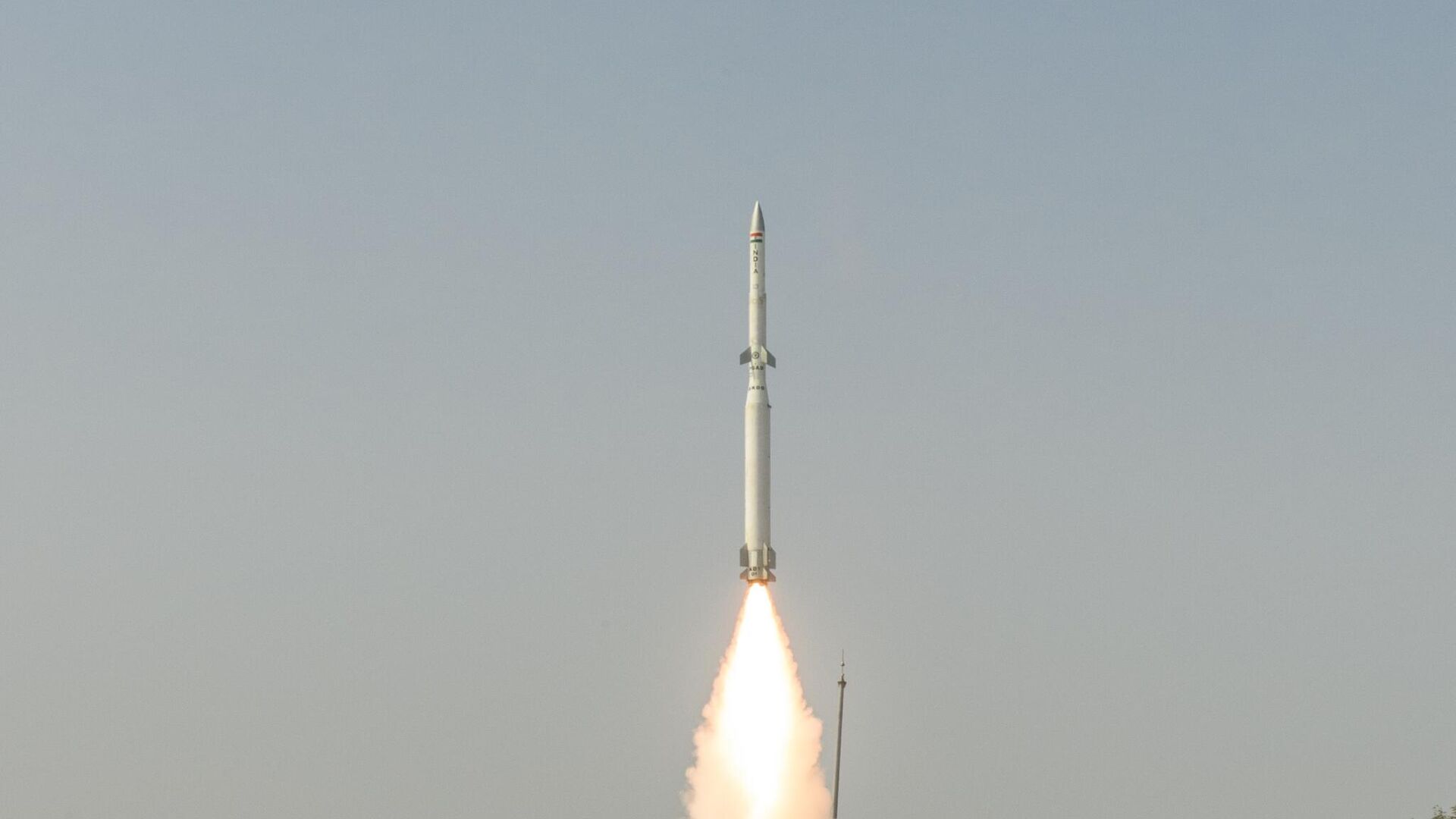https://sputniknews.in/20240725/india-gets-robust-multi-layered-protection-from-incoming-ballistic-missiles-7913127.html
India Gets Robust Multi-Layered Protection From Incoming Ballistic Missiles
India Gets Robust Multi-Layered Protection From Incoming Ballistic Missiles
Sputnik India
The development of a 5,000-km range BMD system has provided India a world-class multi-layered protection from incoming ballistic missiles, an acclaimed missile and rocket scientist previously associated with the Defence Research and Development Organisation (DRDO) has said.
2024-07-25T22:03+0530
2024-07-25T22:03+0530
2024-07-25T22:03+0530
sputnik opinion
india
us
united kingdom (uk)
indian air force (iaf)
ministry of defence (mod)
tactical ballistic missile
intercontinental ballistic missile (icbm)
missiles
drdo
https://cdn1.img.sputniknews.in/img/07e8/07/19/7914817_0:497:2048:1649_1920x0_80_0_0_921ef801f37939dc752189792e986e28.jpg
The development of a 5,000-km range BMD system has provided India a world-class multi-layered protection from incoming ballistic missiles, an acclaimed missile and rocket scientist previously associated with the Defence Research and Development Organisation (DRDO) has said.Considering New Delhi has a "No First Use policy" in place as far as using nuclear weapons is concerned, he added that the successful test of the BMD, which is made up of two interceptor projectiles, is significant for India.While the Prithvi Defence Vehicle is configured to destroy enemy missiles at higher altitudes outside the earth's atmosphere (exo-atmospheric ranges), the Advanced Area Defence missile would be activated to eliminate an incoming missile at a lower elevation (endo-atmosphere).Ramarao revealed that when India began its BMD program, DRDO had planned a Layered Ballistic Missile Defence (BMD) system. Under this, depending on the type of ballistic missile, a particular layer is brought into action to defend the country from enemy threats.He mentioned that previously, the DRDO completed Phase-I trials of the BMD for adversary projectiles having a 2,000-km range. The Indian Armed Forces later deployed this BMD to neutralize incoming aerial threats.On the other hand, military affairs commentator and former Indian Air Force (IAF) pilot Vijainder K. Thakur 5,000 km range missile can reach altitudes of 200-1500 km or more while a 2,000 km range missile typically reaches altitudes of 500-1000 km. This higher coasting altitude poses radar tracking challenges, the Indian Armed Forces veteran observed.The Air Defence-1 or AD-1 missile is designed to intercept a target missile at around 100 km, he pointed out. At that altitude, the speed of a 5,000 km ballistic missile is higher than that of a 2,000 km range interceptor, the expert added.Meanwhile, the Ballistic Missile Defence test on July 24, proved the efficacy of the DRDO-developed Swordfish long-range tracking radar and the interception capability of the AD-1 endo-atmospheric interceptor, Thakur reckoned.Earlier, the Ministry of Defence (MoD) announced that on 24 July India carried out successful flight-testing of Phase-II of the BMD system off its eastern coast. A number of state-of-the-art indigenous technologies developed by various DRDO laboratories have been incorporated in the missile system, the statement reads.
https://sputniknews.in/20240621/indias-new-agni-prime-missile-demonstrates-technological-advances-7675551.html
india
us
united kingdom (uk)
russia
china
israel
Sputnik India
feedback.hindi@sputniknews.com
+74956456601
MIA „Rossiya Segodnya“
2024
Pawan Atri
https://cdn1.img.sputniknews.in/img/07e6/0c/13/139630_147:0:831:684_100x100_80_0_0_8fa2b25903e7787fe6a2698552c167df.png
Pawan Atri
https://cdn1.img.sputniknews.in/img/07e6/0c/13/139630_147:0:831:684_100x100_80_0_0_8fa2b25903e7787fe6a2698552c167df.png
News
en_IN
Sputnik India
feedback.hindi@sputniknews.com
+74956456601
MIA „Rossiya Segodnya“
Sputnik India
feedback.hindi@sputniknews.com
+74956456601
MIA „Rossiya Segodnya“
Pawan Atri
https://cdn1.img.sputniknews.in/img/07e6/0c/13/139630_147:0:831:684_100x100_80_0_0_8fa2b25903e7787fe6a2698552c167df.png
ballistic missile defense, india ballistic missile defense test, india phase-ii ballistic missile defense, india phase-ii ballistic missile defense test, ballistic missile defense test odisha, ballistic missile defense test india, drdo ballistic missile defense, drdo ballistic missile defense test, ballistic missile defense test drdo, indian defense news, indian defense news, ballistic missile defence, ballistic missile defence india,
ballistic missile defense, india ballistic missile defense test, india phase-ii ballistic missile defense, india phase-ii ballistic missile defense test, ballistic missile defense test odisha, ballistic missile defense test india, drdo ballistic missile defense, drdo ballistic missile defense test, ballistic missile defense test drdo, indian defense news, indian defense news, ballistic missile defence, ballistic missile defence india,
India Gets Robust Multi-Layered Protection From Incoming Ballistic Missiles
On Wednesday, India joined a select band of nations to successfully develop a Ballistic Missile Defense (BMD) system. The US, UK, Russia, China, and Israel also have the capability.
The development of a 5,000-km range BMD system has provided India a world-class multi-layered protection from incoming ballistic missiles, an acclaimed missile and rocket scientist previously associated with the Defence Research and Development Organisation (DRDO) has said.
"The successful test of a new 5,000 km range Ballistic Missile is a huge milestone because it provides the next layer of air defence against ballistic missiles. It is a robust multi-layered protector that prevents India's foes from carrying out a large-scale missile attack inside its territory," Dr. Prahalada Ramarao, who headed India's Akash Missile Development Program at the DRDO, told Sputnik India on Thursday.
Considering New Delhi has a
"No First Use policy" in place as far as using nuclear weapons is concerned, he added that the successful test of the BMD, which is made up of
two interceptor projectiles, is significant for India.
While the Prithvi Defence Vehicle is configured to destroy enemy missiles at higher altitudes outside the earth's atmosphere (exo-atmospheric ranges), the Advanced Area Defence missile would be activated to eliminate an incoming missile at a lower elevation (endo-atmosphere).
Ramarao revealed that when India began its BMD program, DRDO had planned a Layered Ballistic Missile Defence (BMD) system. Under this, depending on the type of ballistic missile, a particular layer is brought into action to defend the country from enemy threats.
He mentioned that previously, the DRDO completed Phase-I trials of the BMD for adversary projectiles having a 2,000-km range. The
Indian Armed Forces later deployed this BMD to
neutralize incoming aerial threats.
"However, the successful test of a new 5,000 km range BMD is a huge milestone because it provides the next layer of air defence against ballistic missiles," Ramarao emphasized.
On the other hand, military affairs commentator and former Indian Air Force (IAF) pilot Vijainder K. Thakur 5,000 km range missile can reach altitudes of 200-1500 km or more while a 2,000 km range missile typically reaches altitudes of 500-1000 km. This higher coasting altitude poses radar tracking challenges, the Indian Armed Forces veteran observed.
The Air Defence-1 or AD-1 missile is designed to intercept a target missile at around 100 km, he pointed out. At that altitude, the speed of a 5,000 km ballistic missile is higher than that of a 2,000 km range interceptor, the expert added.
Meanwhile, the Ballistic Missile Defence test on July 24,
proved the efficacy of the DRDO-developed
Swordfish long-range tracking radar and the interception capability of the AD-1 endo-atmospheric interceptor, Thakur reckoned.
"Significantly, DRDO used low latency communication (likely using a LEO satellite) to guide the missile, resulting in greater guidance accuracy," the aviation analyst asserted.
Earlier, the Ministry of Defence (MoD) announced that on 24 July India carried out successful flight-testing of Phase-II of the BMD system off its eastern coast. A number of state-of-the-art indigenous technologies developed by various DRDO laboratories have been incorporated in the missile system, the statement reads.



